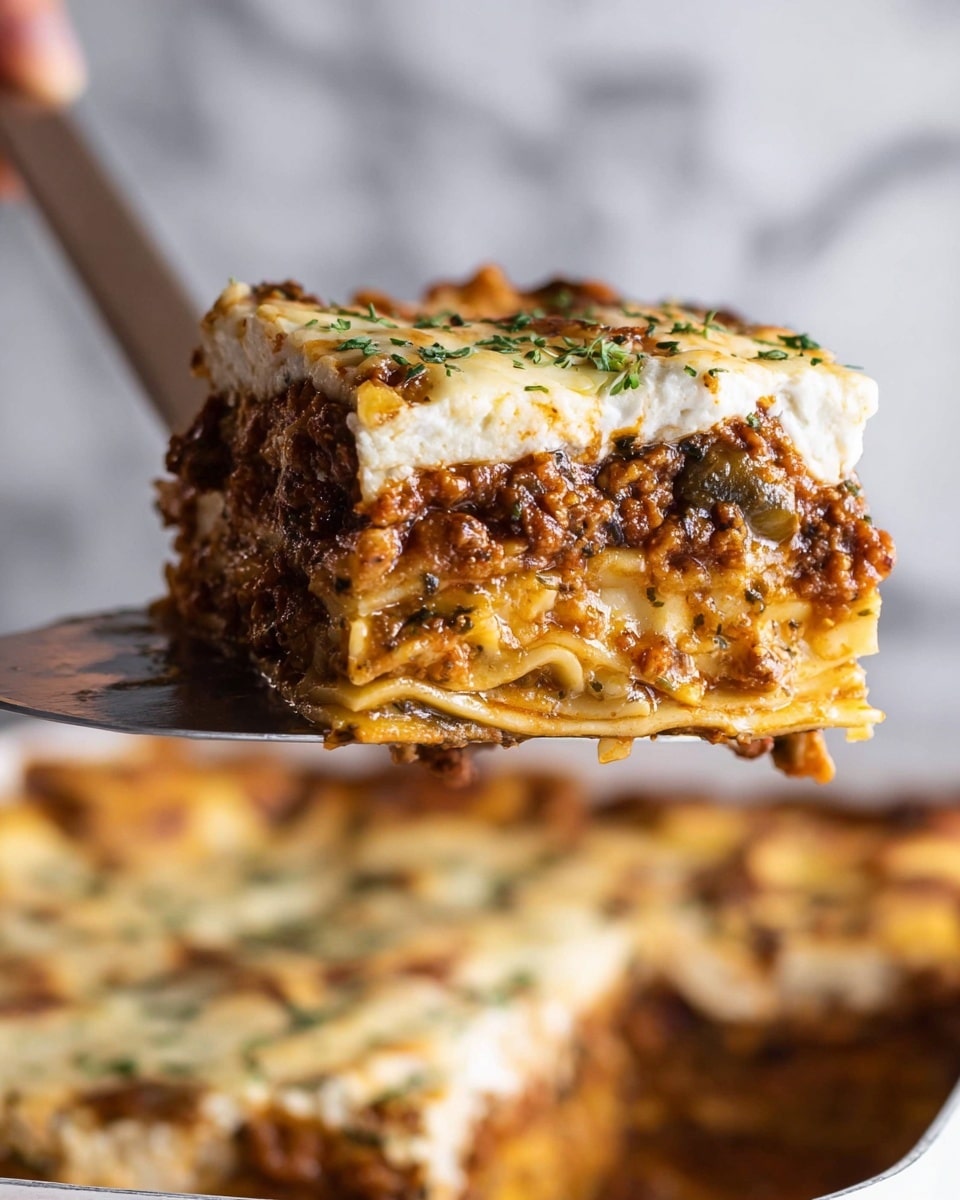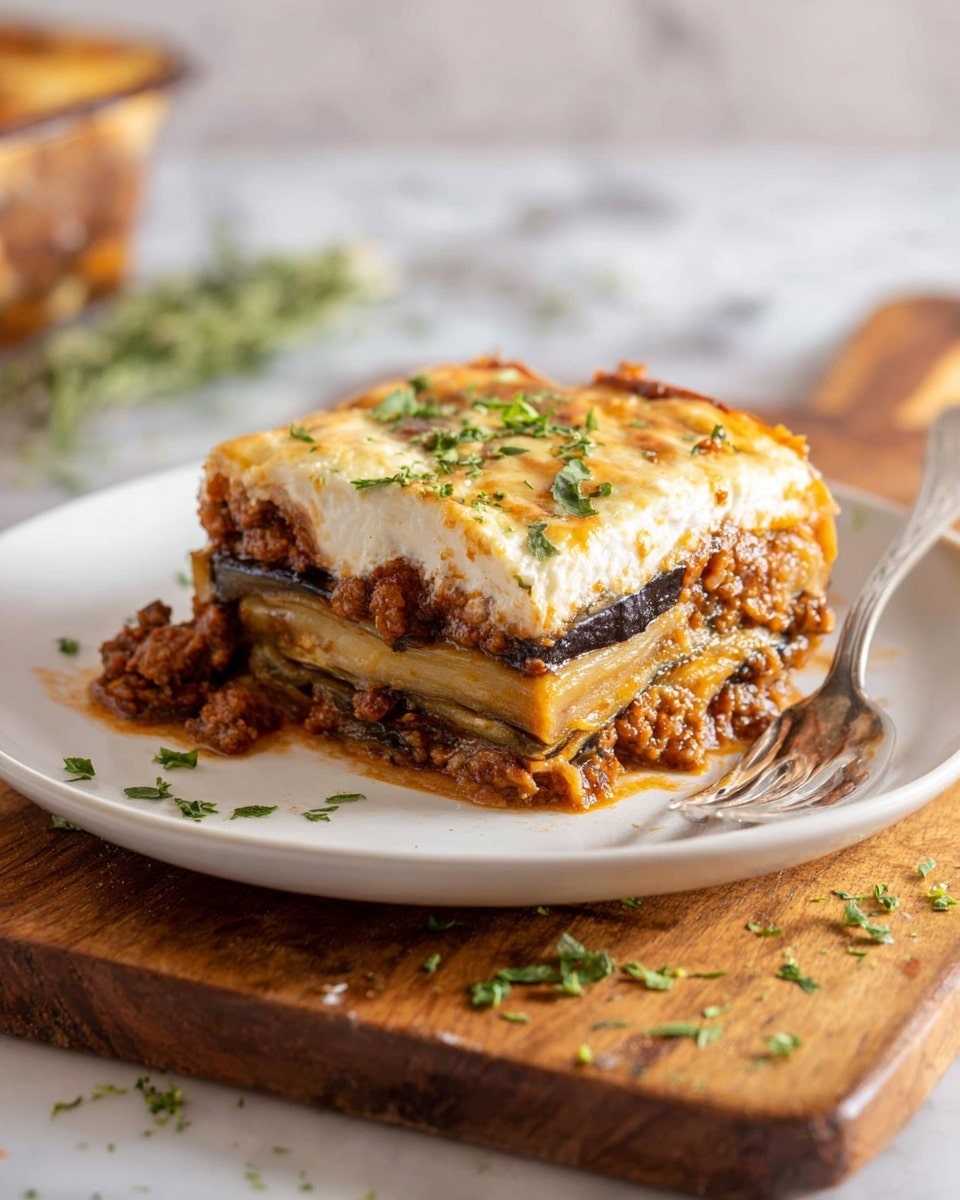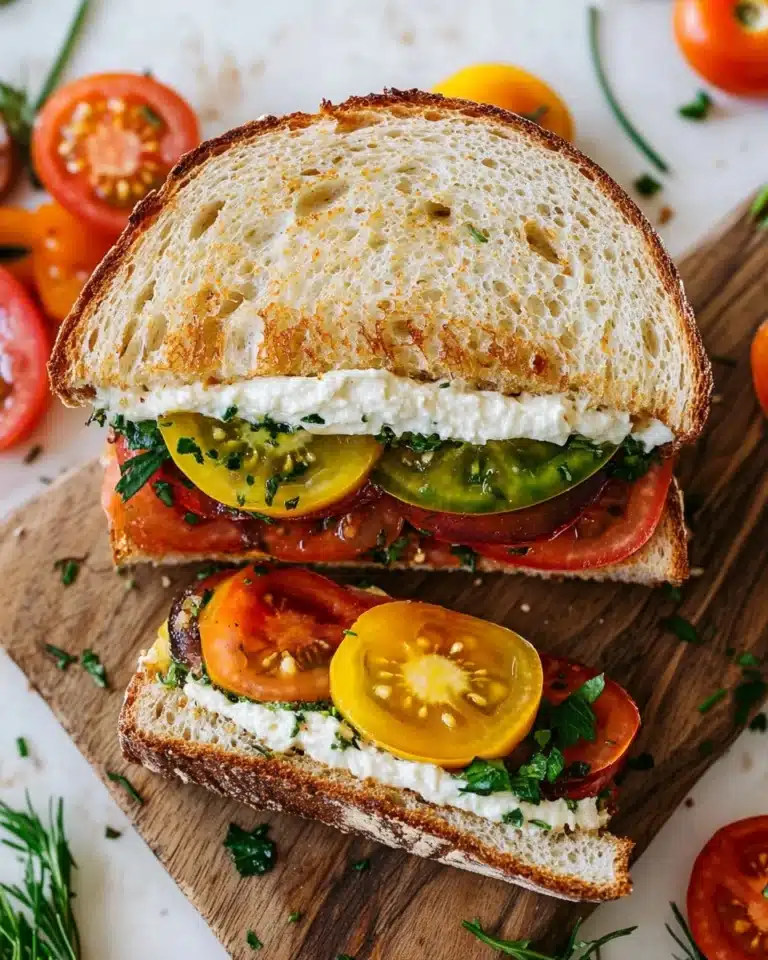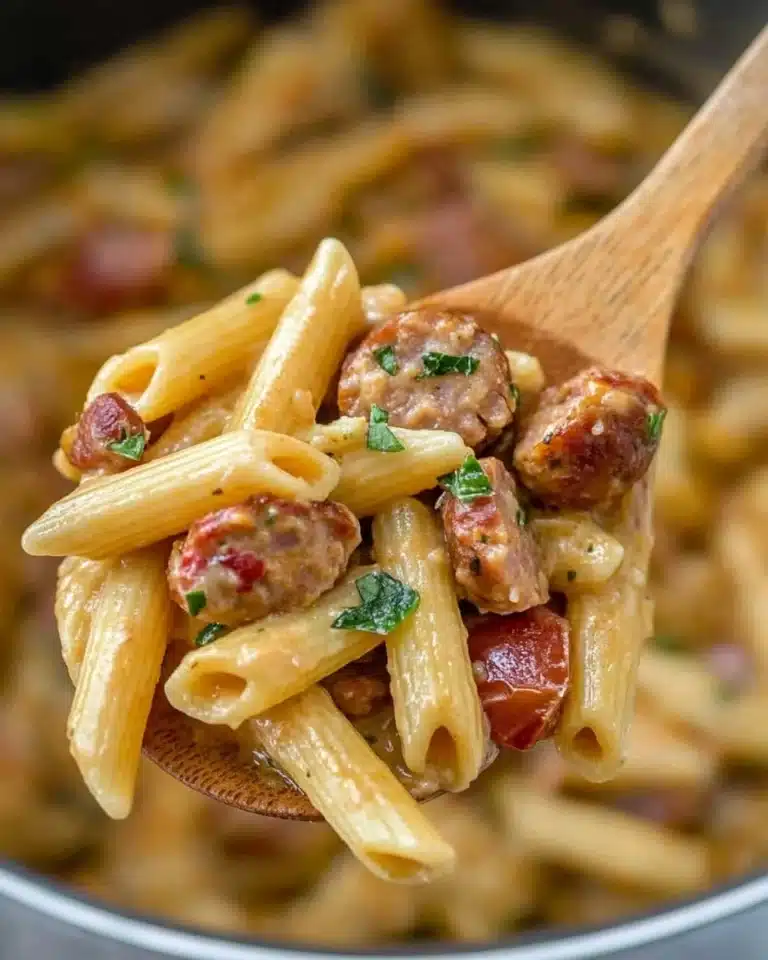I absolutely love sharing this Outrageously Delicious Greek Moussaka Recipe with you because it’s one of those comfort dishes that feels like a warm hug from the inside out. When I first tried this classic, what really stood out was the rich layers of tender vegetables, savory beef, and that creamy béchamel topping—each bite is perfectly balanced and deeply satisfying. Whenever I want to impress guests or simply enjoy a hearty family dinner, this recipe always steals the show.
This dish shines on chilly evenings or whenever you crave something rich yet fresh. Plus, it’s such a rewarding recipe to make because you see all the layers building into a beautiful, golden-baked masterpiece. With the Outrageously Delicious Greek Moussaka Recipe, you’ll find a timeless Greek favorite that’s surprisingly approachable and brings big flavors to your table every time.
Why You’ll Love This Recipe
- Layered Perfection: The combination of potatoes, zucchini, and eggplant with rich beef and creamy béchamel creates a beautifully balanced and hearty meal.
- Authentic Flavor: Using classic Greek spices like cinnamon and fresh herbs gives this dish a genuine taste that you won’t find in most recipes.
- Make-Ahead Friendly: You can prep most components ahead of time, making it perfect for busy days or dinner parties.
- Kid-Approved Comfort: My family goes crazy for this, and I bet yours will too!
Ingredients You’ll Need
The magic of the Outrageously Delicious Greek Moussaka Recipe really comes from the harmony of fresh veggies, savory beef, and a luscious béchamel sauce. When shopping, try to get firm, fresh eggplants and zucchinis, and don’t skip the Pecorino Romano—it adds that sharp, salty punch that brings everything together.
- Olive Oil: Adds authentic Mediterranean flavor and is perfect for sautéing and frying the vegetables.
- White Onion: Finely diced for that sweet, tender base in the beef sauce.
- Garlic: Adds depth and warmth, finely diced to infuse without overpowering.
- Ground/Minced Beef: I like to use lean beef to keep it hearty but not greasy.
- Tomato Paste: Concentrates the tomato flavor in the sauce, making it rich and robust.
- Dry Red Wine: Helps deglaze and adds complexity—if you prefer, substitute with beef stock.
- Tomato Passata: Pureed tomatoes that create a smooth, tangy sauce foundation.
- Beef Stock: Boosts the meaty flavor and keeps the sauce luscious.
- Fresh Parsley: Finely diced, it brightens the whole dish with herbal freshness.
- Fresh Thyme Leaves: A subtle herbaceous note that’s essential to the flavor profile.
- Bay Leaf: Adds that warm, slightly floral aroma to the simmering sauce.
- Salt & Pepper: Season to taste and bring out all the flavors.
- Sugar: Balances the acidity of the tomato sauce just right.
- Cinnamon: A little goes a long way to add that signature Greek moussaka warmth.
- Unsalted Butter: For the béchamel, giving it richness without salt interfering.
- Plain Flour: The thickening agent that makes your béchamel sauce silky and smooth.
- Milk: Room temperature helps prevent lumps in your béchamel.
- Nutmeg: Freshly grated is best, but ground works fine to add subtle spice.
- White Pepper: For a mild peppery flavor in the béchamel without black specks.
- Pecorino Romano: Freshly grated cheese that melts beautifully into the sauce and layers.
- Egg Yolks: Enrich the béchamel, making it creamy and velvety.
- Vegetable or Olive Oil: For frying the vegetables until tender and golden.
- Baking Potatoes: Peeled and sliced thinly to form a sturdy base layer.
- Zucchini/Courgettes: Sliced lengthwise for even cooking and lovely texture.
- Eggplants/Aubergines: Salted to remove bitterness and moisture, then fried for creamy softness.
- Parsley & Pecorino (for sprinkling): To add layers of fresh flavor within the dish.
Variations
I love how versatile this Outrageously Delicious Greek Moussaka Recipe can be. While I keep it traditional most of the time, I’m all for tweaking it to fit your tastes or dietary needs—making it your own is part of the fun!
- Vegetarian Version: I’ve swapped the ground beef for lentils or mushrooms before, and it still packs a punch in flavor and texture.
- Cheese Swap: Using Parmesan instead of Pecorino works well if you prefer a milder, less salty touch.
- Oven-Baked Veggies: When I want to skip frying, roasting the eggplant, zucchini, and potatoes works nicely—they caramelize deliciously in the oven.
- Spice Level: For a little kick, add a pinch of chili flakes into the beef sauce. My family loves the subtle heat it brings.
How to Make Outrageously Delicious Greek Moussaka Recipe
Step 1: Sauté the Beef Layer to Perfection
Start by heating your olive oil in a large pan over medium heat. Toss in the finely diced onion and sauté until it’s soft and golden—that sweet aroma is your cue to add the garlic. After about a minute, add the ground beef, breaking it apart with your spoon, and cook until well browned. Stir in the tomato paste and fry it for a couple of minutes to deepen that rich flavor. Next, pour in the red wine and give it a good scrape to deglaze the pan, lifting all those delicious brown bits. Pour in the tomato passata and beef stock, then season with parsley, thyme, cinnamon, salt, sugar, pepper, and the bay leaf. Let it all simmer gently for about 30 minutes until thickened and deeply flavored—remember to stir occasionally so it doesn’t stick or burn.
Step 2: Prep and Press Your Veggies
While the beef simmers, lay out some paper towels on a flat surface and start layering: eggplant slices first, sprinkle both sides with salt to draw out moisture and any bitterness. Then, top with a couple of paper towel layers, followed by zucchini slices, more paper towels, then potato slices, and finish with a final paper towel layer. Give it a gentle press to soak up moisture from all the veggies. This little trick makes frying so much easier and ensures your moussaka isn’t soggy—trust me, I learned this the hard way!
Step 3: Fry Each Vegetable Layer Just Right
Heat enough oil in a pan to cover your vegetables, aiming for around 150°C (300°F). Start frying the potato slices until they’re tender and lightly golden, then set them on fresh paper towels to drain excess oil. Increase the heat slightly to 170°C (340°F) and fry the zucchini until softened and nicely browned. Finish by frying the eggplant slices the same way. Draining them well on paper towels after frying is key to avoiding greasy layers, so don’t rush this step—your moussaka will thank you! If you prefer, roasting the veggies works too, just toss them with oil and salt and bake at 400°F until golden.
Step 4: Whip Up That Creamy Béchamel Sauce
Melt the butter in a pot over medium heat and stir in the flour to form a smooth roux. Gradually whisk in your room temperature milk to prevent lumps, cooking until the sauce thickens enough to coat the back of a spoon—that’s the perfect consistency. Season with salt, white pepper, and freshly grated nutmeg. Take the sauce off the heat and stir in the grated Pecorino Romano until lump-free. Finally, quickly whisk in the egg yolks for that irresistible, velvety finish. Don’t skip stirring the egg yolks in quickly—this step gives your moussaka that signature golden top and creamy texture.
Step 5: Assemble Your Outrageously Delicious Greek Moussaka
Start by layering the potatoes in your baking dish, overlapping slightly and sprinkling parsley, pecorino, salt, and pepper over them. Next, add the zucchini with the same seasoning, followed by half of your eggplants. Try to keep it compact by filling any gaps—that way every forkful is a perfect bite. Spread the thick beef sauce evenly over this layer, then top with the remaining eggplants. Pour the béchamel sauce generously over the top and finish with a sprinkle of pecorino for that golden crust once baked.
Step 6: Bake to Golden Perfection and Serve
Bake your assembled moussaka in a preheated oven at 180°C (350°F) for 35-45 minutes until the top is beautifully golden and lightly charred. I always recommend letting it sit for at least 15 minutes after baking so it sets properly—cutting into it too soon can make it fall apart. When you do serve, garnish with extra parsley and enjoy the layers of melt-in-your-mouth flavor with family or friends.
Pro Tips for Making Outrageously Delicious Greek Moussaka Recipe
- Salting the Eggplant: I always salt and press my eggplant slices for at least 20 minutes to avoid bitterness and excess moisture.
- Temperature Control When Frying: Keeping the oil at the right temperatures for each veggie prevents sogginess and ensures they’re tender and golden.
- Smooth Béchamel Sauce: Pour milk gradually and whisk constantly to avoid lumps; a smooth béchamel really elevates the whole dish.
- Rest Before Slicing: Let your moussaka rest for 15-20 minutes after baking to help all layers set and make slicing clean and easy.
How to Serve Outrageously Delicious Greek Moussaka Recipe
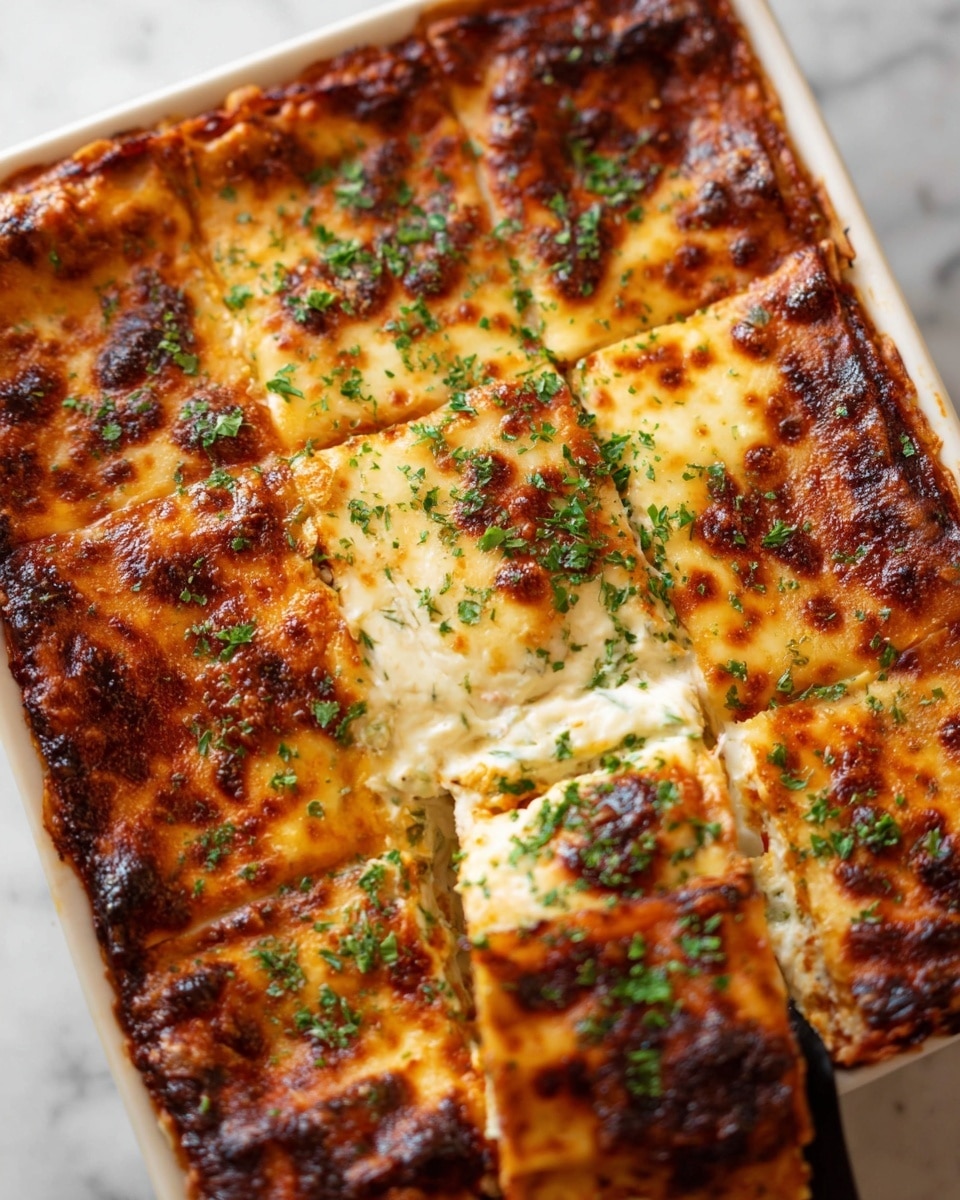
Garnishes
I love topping my moussaka with fresh chopped parsley for a pop of color and brightness. Sometimes, I sprinkle a little extra pecorino on top just before serving to add an extra cheesy note that melts just perfectly against the warm layers underneath.
Side Dishes
This recipe pairs wonderfully with a simple Greek salad loaded with tomatoes, cucumber, olives, and feta cheese. For lighter sides, warm pita bread or a side of lemony roasted vegetables complement the hearty moussaka without overpowering it.
Creative Ways to Present
For special occasions, I’ve served individual portions of moussaka in small ramekins topped with a sprig of thyme and a dusting of pecorino for an elegant touch. You can also create layered moussaka “cups” using filo pastry for a fun finger-food twist that’s always a party favorite!
Make Ahead and Storage
Storing Leftovers
I store leftover moussaka covered in an airtight container in the fridge, where it keeps beautifully for up to 3 days. The flavors actually deepen overnight, so I often enjoy it just as much—or even more—the next day!
Freezing
I’ve found that moussaka freezes well in portions wrapped tightly in plastic wrap and foil. When you’re ready, just thaw overnight in the fridge, and it’s almost as good as freshly baked. Great for batch cooking!
Reheating
To reheat, I cover the moussaka with foil and warm it in a 350°F oven until heated through—about 20-25 minutes. This keeps the béchamel creamy and the vegetables tender without drying out the dish.
FAQs
-
Can I make this Outrageously Delicious Greek Moussaka Recipe vegetarian?
Absolutely! You can substitute the ground beef with lentils, finely chopped mushrooms, or a mix of both to create a satisfying vegetarian version. Simply cook them with the same seasonings as the beef layer, and you’ll get a hearty, delicious moussaka without meat.
-
Do I have to fry all the vegetables?
While frying the vegetables gives the most authentic flavor and texture, roasting them in the oven is a great alternative if you want to skip the extra oil. Just coat the slices lightly with olive oil, season, and roast at 400°F until tender and golden.
-
What’s the key to a smooth béchamel sauce for moussaka?
Use room temperature milk and add it gradually while whisking constantly to avoid lumps. Cooking the roux (butter and flour mixture) until slightly golden before adding milk also helps, plus whisking off the heat when adding cheese and egg yolks keeps the sauce silky smooth.
-
How long should I let the moussaka rest before serving?
Let it rest for at least 15 minutes after baking. This helps the layers set so it slices cleanly and keeps its shape on the plate—a little patience goes a long way!
Final Thoughts
This Outrageously Delicious Greek Moussaka Recipe is truly one of those dishes that feels special every time I make it. It brings layers of flavor and tradition to the table with a rich, comforting silhouette that’s perfect for gatherings or family dinners alike. If you’re ready to impress and satisfy with a classic that’s stood the test of time, give this recipe a go—you’ll enjoy every moment of making and eating it as much as I do!
Print
Outrageously Delicious Greek Moussaka Recipe
- Prep Time: 40 min
- Cook Time: 70 min
- Total Time: 110 min
- Yield: 8 servings
- Category: Main Course
- Method: Baking
- Cuisine: Greek
Description
Outrageously Delicious Greek Moussaka is a classic layered casserole featuring seasoned ground beef, tender fried vegetables, and a creamy béchamel sauce. This hearty and comforting dish is baked to golden perfection, combining the flavors of cinnamon, nutmeg, and fresh herbs for an authentic Mediterranean experience. A perfect centerpiece for family dinners or special occasions, it offers a delicious harmony of textures and rich, savory taste.
Ingredients
Beef Layer
- 1 tbsp Olive Oil
- 1 large White Onion, finely diced
- 2 cloves Garlic, finely diced
- 1.6lb / 750g Ground/Minced Beef (preferably fairly lean)
- 2 heaped tbsp Tomato Paste
- 1/2 cup / 120ml Dry Red Wine (or substitute beef stock)
- 1 cup / 240ml Tomato Passata
- 1 cup / 240ml Beef Stock
- 1/4 cup finely diced Fresh Parsley, plus extra to serve
- 1 tbsp finely diced Fresh Thyme Leaves
- 2 small or 1 large Bay Leaf
- 3/4 tsp Salt, or to taste
- 1/2 tsp Sugar
- 1/2 tsp Cinnamon
- 1/4 tsp Black Pepper, or to taste
Béchamel Sauce
- 4oz / 120g Unsalted Butter
- 4oz / 120g Plain Flour
- 4 cups / 1 litre Milk, at room temperature
- 1/2 tsp Salt, or to taste
- 1/2 small Nutmeg, grated (or 1/4 tsp ground nutmeg)
- 1/4 tsp White Pepper
- 1 cup / 80g freshly grated Pecorino Romano
- 2 Egg Yolks
Vegetable Layer
- 2 cups / 480ml Vegetable or Olive Oil, or enough to cover vegetables in the pan
- 1.6lb / 750g (approx 2 large) Baking Potatoes, peeled and sliced about 1/4"
- 1lb / 500g (approx 2 medium) Zucchini/Courgettes, sliced into approx 1/3" strips lengthways
- 2lb / 1kg (approx 4 smallish) Eggplants/Aubergine, sliced
- Few pinches of Parsley and Pecorino to sprinkle between layers
- Salt and Pepper as needed
Instructions
- Prepare Beef Layer: Heat olive oil in a large pan over medium heat. Sauté diced onion until soft and golden, then add garlic and cook for another minute. Add ground beef and brown thoroughly, breaking it up as it cooks. Stir in tomato paste and fry for 2 minutes. Pour in red wine to deglaze the pan, then add tomato passata and beef stock. Season with parsley, thyme, bay leaf, salt, sugar, cinnamon, and black pepper. Simmer gently for 30 minutes, stirring occasionally until thickened.
- Prep Vegetable Layer: Arrange paper towels on a flat surface. Layer eggplant slices on towels, sprinkle salt on both sides, then cover with two layers of paper towels. Add zucchini slices next, covered by a paper towel, followed by potato slices topped with another paper towel. Gently press down to draw out excess moisture from the vegetables.
- Cook Vegetable Layer: Heat vegetable or olive oil in a deep pan to about 150C (300F). Fry potato slices until lightly golden and fork-tender; drain on paper towels. Increase oil temperature to 170C (340F) and fry zucchini slices until softened and browned, then fry eggplant slices last. Drain all vegetables on paper towels to remove excess oil.
- Make Béchamel Sauce: Melt butter in a pot over medium heat. Stir in flour to form a roux, then gradually whisk in milk to avoid lumps. Cook until thick enough to coat the back of a spoon. Season with salt, white pepper, and grated nutmeg. Remove from heat, stir in Pecorino Romano until smooth, then quickly whisk in egg yolks. Reserve half a cup of sauce to stir into the beef mixture.
- Assemble Moussaka: Spread a layer of potato slices in a baking dish, sprinkling parsley, Pecorino, salt, and pepper. Add zucchini layer with the same seasoning, then half the eggplant slices seasoned with salt and pepper. Press layers compactly, then spread the beef layer over the vegetables. Top with the remaining eggplant slices and pour the béchamel sauce evenly over the top.
- Bake and Serve: Sprinkle extra Pecorino on top and bake in a preheated oven at 180C (350F) for 35-45 minutes until golden and lightly charred. Allow moussaka to rest for at least 15 minutes before slicing to help it hold its shape. Serve warm, garnished with fresh parsley.
Notes
- Moussaka is a traditional Greek dish; frying vegetables to remove excess moisture enhances texture and flavor.
- Paper towel layering and pressing draws out moisture from vegetables, preventing sogginess.
- Using two pans for frying can speed up the cooking process, or you can oven-bake some vegetable layers as a healthier alternative.
- Resting the baked moussaka before serving is crucial for better slicing and presentation.
- You can substitute dry red wine with beef stock if preferred.
- Adjust salt and pepper seasoning according to taste at all stages.
Nutrition
- Serving Size: 1 serving
- Calories: 571 kcal
- Sugar: 14.52 g
- Sodium: 746 mg
- Fat: 29.22 g
- Saturated Fat: 12.344 g
- Unsaturated Fat: 14.811 g
- Trans Fat: 0.427 g
- Carbohydrates: 42.95 g
- Fiber: 6.2 g
- Protein: 34.11 g
- Cholesterol: 141 mg

